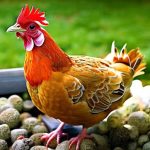Raising chickens and pigs together on farms or homesteads can offer numerous advantages and promote sustainable agricultural practices. These two species possess complementary characteristics that make them well-suited for cohabitation. Chickens are adept foragers and scratchers, while pigs excel at rooting and turning over soil.
This symbiotic relationship can enhance land health and optimize resource utilization. The combination of chickens and pigs can diversify farm products, yielding eggs, meat, and fertilizer. However, successful integration requires careful consideration of each species’ specific needs and behaviors.
This article will examine the benefits of co-raising chickens and pigs, addressing key aspects such as housing and space requirements, feeding and nutrition, health and disease management, and waste management. Additionally, it will provide practical tips for achieving successful cohabitation between these two farm animals.
Table of Contents
- 1 Benefits of Keeping Chickens and Pigs Together
- 2 Considerations for Housing and Space
- 3 Feeding and Nutrition for Chickens and Pigs
- 4 Health and Disease Management
- 5 Managing Waste and Keeping the Environment Clean
- 6 Conclusion and Final Tips for Keeping Chickens and Pigs Together
- 7 FAQs
- 7.1 Can chickens and pigs be kept together?
- 7.2 What are the benefits of keeping chickens and pigs together?
- 7.3 What are the potential challenges of keeping chickens and pigs together?
- 7.4 What precautions should be taken when keeping chickens and pigs together?
- 7.5 Are there any specific housing requirements for keeping chickens and pigs together?
Key Takeaways
- Keeping chickens and pigs together can be beneficial for both animals and the environment.
- Chickens can help control pests and provide additional nutrition for pigs, while pigs can help with waste management.
- Proper housing and space considerations are important to ensure the well-being of both chickens and pigs.
- Feeding and nutrition for chickens and pigs should be carefully managed to meet their specific dietary needs.
- Health and disease management, as well as waste management, are crucial aspects of keeping chickens and pigs together.
Benefits of Keeping Chickens and Pigs Together
Complementary Behaviors
One of the main advantages is the complementary behaviors of the two animals. Chickens are natural foragers and scratchers, while pigs are excellent at rooting and turning over soil.
Improved Land Health
By allowing these animals to cohabitate, they can work together to improve the overall health of the land. For example, chickens can help control pests and insects by foraging for them, while pigs can help aerate and fertilize the soil through their rooting behavior. This can result in healthier pastures and improved soil quality, which can benefit other crops or livestock on the farm.
Diverse Range of Products
Additionally, the combination of chickens and pigs can provide a diverse range of products for the farm. Chickens can provide eggs, while pigs can provide meat. Furthermore, both animals produce valuable fertilizer that can be used to improve soil fertility.
Sustainable Farming
Overall, keeping chickens and pigs together can lead to a more sustainable and efficient use of resources on the farm.
Considerations for Housing and Space

When keeping chickens and pigs together, it is important to consider the housing and space requirements for both animals. Chickens require a secure coop or housing structure to protect them from predators and the elements. The coop should also provide nesting boxes for laying eggs and perches for roosting.
Pigs, on the other hand, require a sturdy shelter that can protect them from extreme weather conditions. Additionally, pigs need access to a wallow or mud hole to help regulate their body temperature and protect their skin from sunburn. When it comes to space requirements, both chickens and pigs need ample room to move around and exhibit natural behaviors.
Chickens require at least 2-3 square feet of space per bird in the coop, as well as access to an outdoor run or pasture area. Pigs need a minimum of 50 square feet per animal for outdoor space, with access to pasture or wooded areas for rooting and foraging. It is important to provide separate areas for chickens and pigs to prevent competition for resources and potential aggression between the two species.
Feeding and Nutrition for Chickens and Pigs
Feeding and nutrition are important considerations when keeping chickens and pigs together. Both animals have specific dietary needs that must be met in order to maintain their health and productivity. Chickens are omnivores and require a balanced diet that includes grains, protein sources (such as insects or mealworms), greens, and calcium for egg production.
Pigs are omnivores as well, but they require a diet that is higher in protein and energy to support their growth and muscle development. When keeping chickens and pigs together, it is important to provide separate feeders for each species to prevent competition for food. Additionally, it is important to monitor the feeding habits of both animals to ensure that they are receiving adequate nutrition.
Supplementing their diets with kitchen scraps or surplus produce from the garden can also help reduce feed costs and provide additional nutrients. It is important to consult with a veterinarian or animal nutritionist to develop a feeding program that meets the specific needs of both chickens and pigs.
Health and Disease Management
Health and disease management are crucial aspects of keeping chickens and pigs together. Both animals are susceptible to a variety of diseases and parasites that can impact their overall health and productivity. It is important to implement biosecurity measures to prevent the introduction and spread of diseases on the farm.
This includes quarantining new animals before introducing them to the existing flock or herd, as well as practicing good hygiene and sanitation practices. Regular health checks by a veterinarian can help identify any potential health issues early on and prevent the spread of disease. Additionally, it is important to provide appropriate vaccinations and parasite control measures for both chickens and pigs.
Monitoring the behavior and appearance of both animals can also help identify any signs of illness or distress. By implementing proactive health management practices, farmers can help ensure the overall well-being of their chickens and pigs.
Managing Waste and Keeping the Environment Clean

Understanding Manure Composition
When keeping chickens and pigs together, managing waste is crucial to prevent environmental contamination and odors. The manure produced by these animals has different compositions, with chicken droppings being high in nitrogen and pig manure being higher in phosphorus.
Regular Cleaning and Composting
Regular cleaning of coops and pig shelters is essential to prevent the buildup of manure, which can attract flies and harbor pathogens. Proper composting of manure can help reduce odors and pathogens, as well as produce valuable fertilizer for the farm. This practice also helps minimize the impact of manure on water quality, especially if the farm is located near a water source.
Rotational Grazing for Even Manure Distribution
Implementing rotational grazing practices can help distribute manure more evenly across pastures, reducing the risk of nutrient runoff. This approach ensures that the manure is spread out, minimizing the concentration of nutrients in a single area.
By managing waste effectively, farmers can help keep the environment clean and minimize the impact of animal production on surrounding ecosystems.
Conclusion and Final Tips for Keeping Chickens and Pigs Together
In conclusion, keeping chickens and pigs together can be a beneficial practice for farmers looking to improve the sustainability of their operations. The complementary behaviors of these animals can help improve soil health, provide diverse products for the farm, and make more efficient use of resources. However, it is important to carefully consider the specific needs of both chickens and pigs when cohabitating them.
Providing appropriate housing and space, developing a balanced feeding program, implementing proactive health management practices, and managing waste effectively are all crucial aspects of successfully keeping chickens and pigs together. By taking these considerations into account, farmers can create a harmonious environment where both animals can thrive while contributing to the overall health of the farm. Some final tips for keeping chickens and pigs together include regularly monitoring the behavior and health of both animals, providing enrichment activities to prevent boredom and aggression, and seeking advice from experienced farmers or agricultural professionals.
By staying informed about best practices for cohabitating chickens and pigs, farmers can create a sustainable system that benefits both animals and the environment. With careful planning and management, keeping chickens and pigs together can be a rewarding endeavor that contributes to a more diverse and resilient farm ecosystem.
If you’re considering keeping chickens and pigs together, it’s important to provide the right housing for your chickens. According to Poultry Wizard, the type of coop you choose can greatly impact the well-being of your chickens. The Producers Pride Sentinel Chicken Coop is a popular option for keeping chickens safe and comfortable. It’s also important to consider the compatibility of different poultry species, as discussed in the article about whether guinea fowl can live with chickens.
FAQs
Can chickens and pigs be kept together?
Yes, chickens and pigs can be kept together in the same area, as long as proper precautions are taken to ensure the safety and well-being of both animals.
What are the benefits of keeping chickens and pigs together?
Keeping chickens and pigs together can provide a natural and symbiotic relationship, as the chickens can help control pests and insects in the pig’s environment, while the pigs can benefit from the chicken’s waste and help keep the area clean.
What are the potential challenges of keeping chickens and pigs together?
One potential challenge of keeping chickens and pigs together is the risk of aggression or injury, as pigs can be aggressive towards chickens, especially during feeding times. Additionally, there may be concerns about disease transmission between the two species.
What precautions should be taken when keeping chickens and pigs together?
When keeping chickens and pigs together, it is important to provide separate feeding areas to minimize competition and aggression. Additionally, regular monitoring of the animals’ health and behavior is essential to ensure their well-being.
Are there any specific housing requirements for keeping chickens and pigs together?
When keeping chickens and pigs together, it is important to provide adequate space for both species, as well as separate areas for nesting, roosting, and feeding. Additionally, the housing should be secure to prevent escapes and protect the animals from predators.
Meet Walter, the feathered-friend fanatic of Florida! Nestled in the sunshine state, Walter struts through life with his feathered companions, clucking his way to happiness. With a coop that’s fancier than a five-star hotel, he’s the Don Juan of the chicken world. When he’s not teaching his hens to do the cha-cha, you’ll find him in a heated debate with his prized rooster, Sir Clucks-a-Lot. Walter’s poultry passion is no yolk; he’s the sunny-side-up guy you never knew you needed in your flock of friends!







